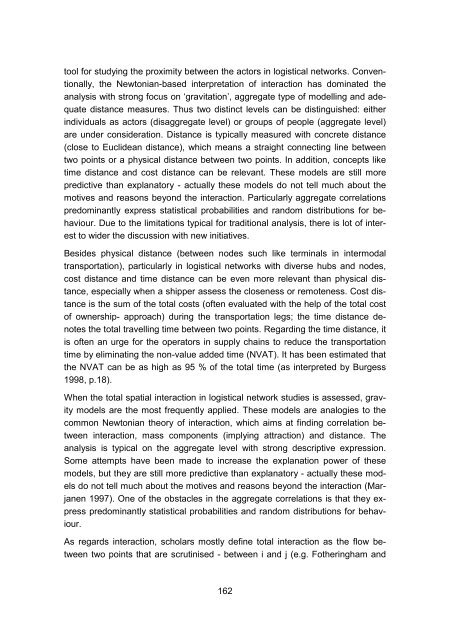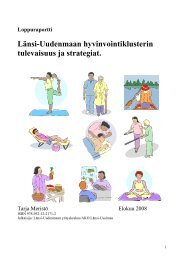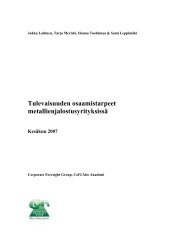849954 sisus
849954 sisus
849954 sisus
You also want an ePaper? Increase the reach of your titles
YUMPU automatically turns print PDFs into web optimized ePapers that Google loves.
tool for studying the proximity between the actors in logistical networks. Conventionally,<br />
the Newtonian-based interpretation of interaction has dominated the<br />
analysis with strong focus on ‘gravitation’, aggregate type of modelling and adequate<br />
distance measures. Thus two distinct levels can be distinguished: either<br />
individuals as actors (disaggregate level) or groups of people (aggregate level)<br />
are under consideration. Distance is typically measured with concrete distance<br />
(close to Euclidean distance), which means a straight connecting line between<br />
two points or a physical distance between two points. In addition, concepts like<br />
time distance and cost distance can be relevant. These models are still more<br />
predictive than explanatory - actually these models do not tell much about the<br />
motives and reasons beyond the interaction. Particularly aggregate correlations<br />
predominantly express statistical probabilities and random distributions for behaviour.<br />
Due to the limitations typical for traditional analysis, there is lot of interest<br />
to wider the discussion with new initiatives.<br />
Besides physical distance (between nodes such like terminals in intermodal<br />
transportation), particularly in logistical networks with diverse hubs and nodes,<br />
cost distance and time distance can be even more relevant than physical distance,<br />
especially when a shipper assess the closeness or remoteness. Cost distance<br />
is the sum of the total costs (often evaluated with the help of the total cost<br />
of ownership- approach) during the transportation legs; the time distance denotes<br />
the total travelling time between two points. Regarding the time distance, it<br />
is often an urge for the operators in supply chains to reduce the transportation<br />
time by eliminating the non-value added time (NVAT). It has been estimated that<br />
the NVAT can be as high as 95 % of the total time (as interpreted by Burgess<br />
1998, p.18).<br />
When the total spatial interaction in logistical network studies is assessed, gravity<br />
models are the most frequently applied. These models are analogies to the<br />
common Newtonian theory of interaction, which aims at finding correlation between<br />
interaction, mass components (implying attraction) and distance. The<br />
analysis is typical on the aggregate level with strong descriptive expression.<br />
Some attempts have been made to increase the explanation power of these<br />
models, but they are still more predictive than explanatory - actually these models<br />
do not tell much about the motives and reasons beyond the interaction (Marjanen<br />
1997). One of the obstacles in the aggregate correlations is that they express<br />
predominantly statistical probabilities and random distributions for behaviour.<br />
As regards interaction, scholars mostly define total interaction as the flow between<br />
two points that are scrutinised - between i and j (e.g. Fotheringham and<br />
162








